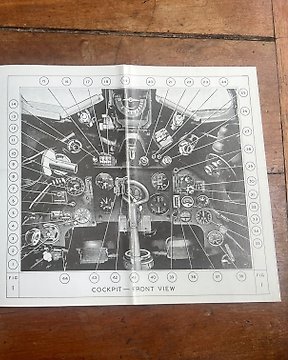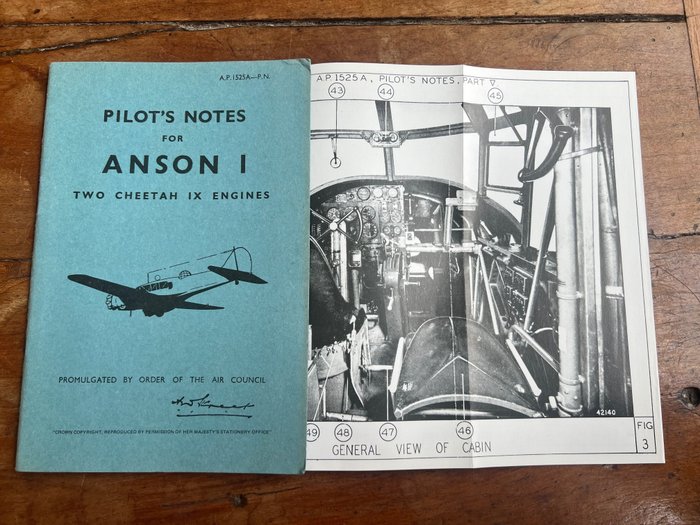
United Kingdom / USA - RAF Royal Air Force Flying Handbook Hawker Sea Fury Fighter aircraft - Pilot Training Manual - Airforce - 1950
N.º 82094041

N.º 82094041

Great pilot training manual for the famous Anson I Multi-role aircraft. The Avro Anson is a British twin-engine, multi-role aircraft built by the aircraft manufacturer Avro. Large numbers of the type served in a variety of roles for the Royal Air Force (RAF), Fleet Air Arm (FAA), Royal Canadian Air Force (RCAF), Royal Australian Air Force and numerous other air forces before, during, and after the Second World War.
Some discoloration and some wear/soiling to the back and first page, especially on the edgess and the back. The cover kept the inside booklet in good condition.
Great cover and illustrations, interestng item for the WW2 Airforce enthusiast!
History of the Anson I aircraft
On 6 March 1936, the Anson entered RAF service, No. 48 Squadron was the first RAF unit to be equipped with the type. Upon the type's introduction, it represented a new level of capability for the service, serving not only in a general reconnaissance capacity but also being an effective general-purpose aircraft[12] In July 1937, a Coastal Command Anson was fitted with an experimental airborne early warning radar which was able to detect large warships 5 miles (8.0 km) away in poor visibility and was successfully used in fleet exercises off the east coast of England in September.[23]
By the outbreak of the Second World War, the RAF had received a total of 824 Ansons while there were 26 RAF squadrons that were then operating the Anson I: 10 of these were assigned to Coastal Command and the other 16 were with Bomber Command.[24] By 1939, all of the squadrons assigned to Bomber Command that had been equipped with the Anson I served as operational training squadrons which were used to prepare crews for frontline service. 12 of the squadrons were in No. 6 (Operational Training) Group. Newly formed crews, having previously completed individual flying and technical training courses, were first trained as bomber crews in Ansons before advancing to the various frontline aircraft types, which were in the same squadrons with the Ansons. After training the crews would advance to the frontline bomber squadrons with aircraft such as the Fairey Battle, Bristol Blenheim, Vickers Wellington, Armstrong Whitworth Whitley or Handley-Page Hampden.
Even before the start of the war, it had been realized that the Anson's limited capabilities would make it ineffective in its intended main role as a maritime patrol aircraft. In 1938, it had been decided to replace the Anson in this role with the American-built Lockheed Hudson, which was 100 mph faster, had three times the range, carried a much heavier bomb load and had a superior defensive armament. The first squadron to be reequipped with the type was already training with them in September 1939. Meanwhile, the remaining Coastal Command Anson squadrons had to go to war with what they had. The Anson had an endurance of only four hours so it could only be employed in the North Sea and other coastal areas; however, it lacked the range to reach the coast of Norway. Its weapons against German U-boats were two small 100 lb bombs, which required a direct hit on the hull of a submarine to be effective, at least in theory. On 3 December 1939, an Anson mistakenly attacked a surfaced Royal Navy submarine, HMS Snapper, and although the aircraft succeeded in hitting the conning tower, the only damage was four broken light bulbs. In an earlier friendly fire incident off the coast of Scotland in September, the bombs of an Anson of No. 233 Squadron had bounced off the surface of the water and exploded in an air burst, which holed the aircraft's fuel tanks causing it to ditch off St Andrews.[23] Despite numerous claims of attacks on U-boats by Ansons in the first months of the war, postwar examination of German records showed that little damage had been inflicted.[citation needed] Despite their obsolescence, Ansons were employed during the Dunkirk evacuation to deter attacks on Allied shipping by German E-boats.[25] On 1 June 1940, a flight of three Ansons was attacked near Dunkirk by nine Luftwaffe Messerschmitt Bf 109s. According to the unsubstantiated claims, one Anson destroyed two German aircraft and damaged a third, while no Ansons were lost.[26]
The aircraft achieved more success training pilots for flying multi-engined bombers, such as the Avro Lancaster. Ansons were first deployed to Flying Training Schools in November 1936, replacing the obsolete bombers then used for twin-engine training.[27] The Anson was also used to train the other members of a bomber's aircrew, such as navigators, wireless operators, bomb aimers and air gunners. Postwar, the Anson continued in the training and light transport roles. The last Ansons were withdrawn from RAF service with communications units on 28 June 1968.[11]
During the 1939–45 war years, the British Air Transport Auxiliary operated the Anson as its standard taxi aircraft, using it to carry groups of ferry pilots to and from aircraft collection points. There was no fatal mechanical failure of an Anson in ATA service, and it was typically very well regarded.[28]
The Royal Australian Air Force (RAAF) initially ordered 33 Ansons in November 1935 to fill the maritime reconnaissance role. The first were delivered in 1936 and 48 were in service before the start of the war. The RAAF eventually operated a total of 1,028 Ansons, the majority of these being Mk Is. These aircraft continued to be operated until 1955.[29]
The Royal New Zealand Air Force (RNZAF) operated 23 Ansons as navigation trainers during the Second World War, (alongside the more numerous Airspeed Oxford), and acquired more Ansons as communication aircraft immediately after the war. A preserved navigation trainer is in the Air Force Museum of New Zealand at Wigram.
The Royal Indian Air Force operated several Ansons as part of the No.1 Service Flying Training School (India) for Pilot and Navigation training. These Ansons continued this role post-independence and were retired at an unknown date.[30]
The Royal Canadian Air Force (RCAF) and Royal Canadian Navy (RCN) operated 4,413 Anson aircraft, 1,962 British built and 2,451 Canadian built aircraft.[31] The RCN operated the aircraft until 1952. Although the Canadian Ansons were used throughout the training schools of the British Commonwealth Air Training plan for training aircrew, some aircraft were pressed into operational service with the RCAF's Eastern Air Command. A good example of the training schools' involvement in combat operations with the EAC during the emergency of the battle is illustrated in an article dated 1 March 2006 of the Royal Canadian Legion magazine entitled Eastern Air Command: Air Force, Part 14; the author Hugh A. Haliday wrote: "The need for Atlantic patrols was undiminished, yet the Battle of the St. Lawrence stretched EAC resources. Based at Charlottetown, 31 General Reconnaissance School was mobilized to fly patrols using Avro Ansons, each carrying two 250-pound bombs. At the very outset of the war, the Anson and its ordnance had failed in RAF anti-submarine work. Now in Canada, it was remobilized as an aerial scarecrow. German views varied as to Canadian countermeasures. The captain of U-517 found his operations increasingly restricted by strengthened air patrols. In October 1942, U-69 reported "strong sea patrol and constant patrol by aircraft with radar."
The Egyptian Air Force (EAF) operated a fleet of Ansons in communications and VIP duties. A specially outfitted Anson was presented to the then King of Egypt by the RAF. The Royal Afghan Air Force obtained 13 Anson 18 aircraft for various duties from 1948. These aircraft survived until 1972.
Como comprar na Catawiki
1. Descubra algo especial
2. Faça a licitação vencedora
3. Faça um pagamento seguro